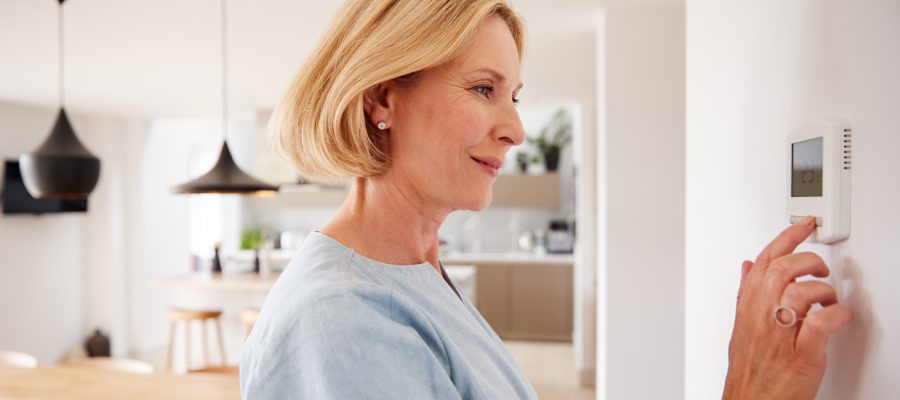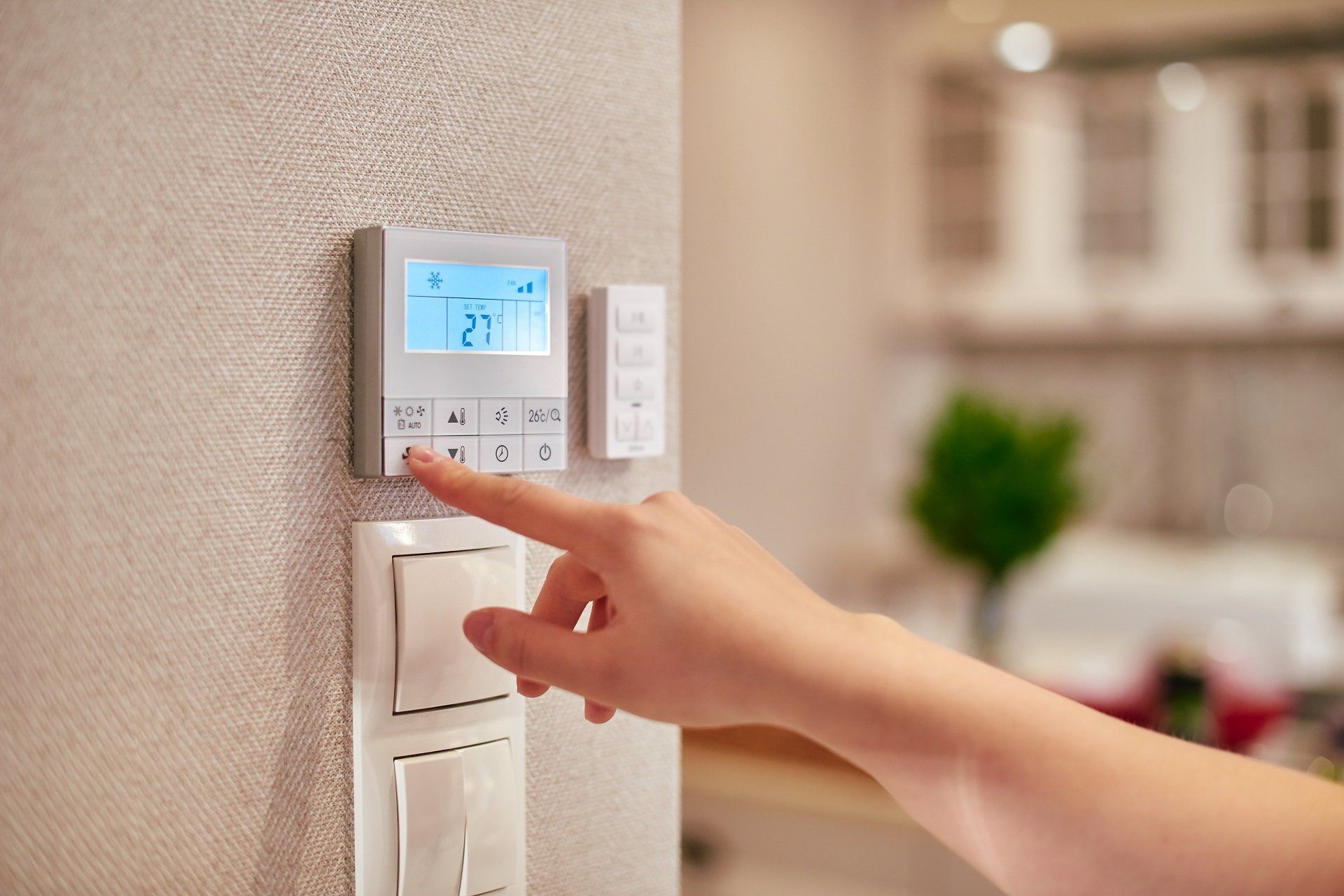Are you looking for an easy and cost-effective way to maximize the efficiency of your heat pump? Non-programmable thermostats can be your best bet!
This guide will help you understand everything about these devices, including their advantages and installation process. You won’t want to miss it!
When it comes to controlling the temperature of a heat pump, non programmable thermostats are often chosen due to the cost efficiency and simple design. To most effectively regulate the environment of your home or office, there are several aspects you need to know before purchasing a non-programmable thermostat.
This guide will offer an in-depth look at the parts, functions, and installation of these thermostats, as well as some recommended models based on accuracy and ease of use.
By having basic knowledge about thermostats and their functions, you can save money on excessive energy costs down the road. You will also be assured that you have a reliable system that is monitoring your home’s temperature efficiently and accurately when temperatures change throughout the day or season. Investing in an appropriate thermostat for your current heating system can make all the difference in improving efficiency and saving money over time!
Explanation of non programmable thermostats and their role in regulating heat pumps
Non-programmable thermostats are basic temperature controlling devices that provide users with the necessary convenience to heat and cool their homes according to preference. They are commonly used for heat pumps, which offer both heating and cooling solutions. Non-programmable thermostats act by monitoring a space’s existing temperature and turning HVAC appliances on or off when the desired temperature is reached. This type of thermostat affords convenience in terms of operation, installation, and affordability.
In a heating or cooling system, a heat pump acts as an air conditioner by exchanging warm or cold air with the outside environment while still providing efficient energy consumption. A non-programmable thermostat connected to the heat pump will monitor indoor temperatures, activate the pump when higher than desired temperatures are met, and deactivate it as soon as indoor temperatures reach desired levels. As such, non-programmable thermostats can help optimize efficiency in any home heating/cooling system using a heat pump.
This device comes in many forms and designs with varying features such as digital indicators for space temperatures or wireless connectivity options that allow people to control air conditioning systems remotely — these variations can suit various consumers’ needs while still adhering to the main purpose of regulating home climates according to user preferences programmed into them. Ultimately, non-programmable models provide a simpler way for users to monitor their HVAC systems without needing complicated systems or extra programs.

Features of Non Programmable Thermostats
Non-programmable thermostats are a popular choice for homes with heat pumps, but they can come with a range of features. Here’s what you need to know about its features:
-An adjustable cycle rate or “on/off” setting: This determines how often your heat pump cycles on and off in order to optimize efficiency. The lower the cycle rate, the more comfortable the temperature setting will be. The higher the temperature, the more your home will be heated relative to its capacity.
-Fan switch: Non-programmable thermostats usually have a fan switch that allows you to control when your fan runs and when it does not. In many cases, you can select whether it runs continuously or cycles on and off depending on your home’s cooling demands.
-Heat anticipator adjustment: This is used for controlling the amount of energy put out by your thermostat at any given moment in order to maintain a consistent temperature throughout your home. Your non-programmable thermostat may have an adjustable heat anticipator that enables you to fine tune how long it takes before your heat pump engages or switches off again in response to changes in the temperature of your home.
-Hold mode: Modern non-programmable thermostats offer a “hold” mode which allows you to override any programmed settings so that you can set temperatures at certain times when needed without having to reprogram each day.
Knowing these features will help you select an appropriate non-programmable thermostat for use with your heat pump system, maximizing efficiency as well as comfort in your home.
Differences between programmable and non programmable thermostats
Choosing between a programmable and a non-programmable thermostat for your heat pump system can be challenging. A programmable thermostat allows you to set automatic temperature settings throughout the day, while a non-programmable thermostat is designed for manual operation only.
Programmable Thermostats:
Programmable thermostats allow you to set multiple temperature settings at different times of the day and night. This allows you to adjust the temperature according to your schedule, allowing you to have a higher temperature when you are home, and then lower it when everyone goes out or to bed. It also helps reduce energy costs by allowing you to turn off the air conditioning when no one is at home, and then have it back up before everyone returns. Programmable thermostats can also be programmed for certain days of the week or for special events, such as holidays or vacations.
Non Programmable Thermostats:
Non-programmable thermostats are designed with simply ON/OFF buttons and no memory feature. With these types of thermostats, users must manually change the temperature each time they would like it changed–which makes them not as efficient in terms of energy savings compared with programmable models–but they are less expensive so if constant manual adjustments are not an issue this could be a cost effective solution. They also often still include some basic features like fan speed control, high-low range options as well as digital displays which make them easier to operate than mechanical or dial models.
Advantages and disadvantages of non programmable thermostats
Non-programmable thermostats offer advantages and disadvantages compared to programmable models. A non-programmable thermostat for a heat pump system is typically the least expensive option, but it requires manual programming of the desired temperature settings. Additionally, some people prefer the manual process of setting temperatures. On the other hand, a non-programmable thermostat will not take into account any changes in sunlight or hours that people are out of the house and cannot make temperature adjustments when no one is home to conserve energy and save on heating/cooling costs.
Some advantages of non-programmable thermostats are their ease of use and cost efficiency. They can be installed quickly, simply replacing an existing model in most cases, with minimal setup required. Furthermore, they are often considered more reliable due to fewer internal components which can break down over time.
On the other hand, some disadvantages arise from their lack of automated programming capabilities. Non-programmable units must be manually adjusted each time a change in desired temperatures is desired. This can cause longer heating/cooling cycles as temperatures cannot be preadjusted over certain periods within a day or week without manually adjusting them every time a change is needed. Moreover, leaving one on for extended periods may lead to unnecessary energy consumption due to inefficiency during peak times or when no one is home to adjust or turn off completely when away from home for long periods of time.
Types of non programmable thermostats and their features
Non-programmable thermostats come in three types: mechanical, digital, and touchscreen. All of them are relatively easy to install and maintain, but each has a unique set of features that can affect your comfort level and energy efficiency. Let’s take a look at what sets them apart.
Mechanical thermostats: These simple devices have no LCD display or buttons. Instead, they usually feature adjustable knobs or dials used to set the thermostat’s temperature settings. They measure the temperature of the environment with a metal probe connected to the knob or dial; when the desired temperature is reached, it activates the heating system. The downside is that you must manually adjust your temperature setting each time the weather changes or you need more heating or cooling in your home.
Digital thermostats: Digital non-programmable models offer greater control options than mechanical models with fewer manual adjustments on your part. This type of thermostat typically includes an LCD display for easier programming and readability as well as buttons for setting up temperatures. Some advanced digital models have additional features like humidity sensors, auto-switch between heat/cool settings, etc., allowing for better control over your comfort levels throughout the year.
Touchscreen thermostats: Touchscreen non-programmable HVAC systems are designed with modern technology in mind – they feature a large backlit color screen that can be activated by touch or voice commands, as well as optional WiFi connectivity for remote monitoring and programming capabilities via smartphone apps or websites (in selected models). In general, this type of device offers excellent customization options so users can tailor their home’s climate control to meet their personal preferences with minimal effort required on their part.

How to Install a Non Programmable Thermostat for Heat Pumps
Installing a non programmable thermostat for a heat pump can be done in just a few steps. First, you’ll need to purchase a thermostat with the right set of features and connectors for your model of heat pump. You also need to make sure that it’s compatible with your specific type – air source or geothermal, among others.
Once you have your new thermostat in hand, turn off the power at the circuit breaker box. Remove all existing wiring from the old thermostat, including the ground or common wire if present. Next, connect the wiring using exactly the same connections as before (if there were multiple wires connected in one location on the old thermostat, make sure they are all connected to exactly the same location on your new unit).
Tighten all wires fully and insert them into their respective terminals on the back of the thermostat. At this point, you should also take a few minutes to ensure that your furnace is compatible and operational before installing the new wiring connections. Then locate an appropriate mounting spot on an interior wall near where most people will pass by or interact – above or below an electrical outlet is best – and mount using either screws or wall anchor hooks (depending on preference and situation).
Finally, re-energize power to circuit breaker box; hang cover plate; set temperature levels; select system mode based on seasonality; input additional information such as location-based energy rate schedules if necessary; and check operation over several days looking for irregularities or wrong settings to correct accordingly after consulting manufacturer instruction manual if need be.
Step-by-step instructions for installing a non programmable thermostat
Installing a non-programmable thermostat is relatively simple and can typically be done in about an hour. While some parts of the process may vary slightly depending on the model you are using, there are some general guidelines you should follow for a successful installation. Below, we have outlined step-by-step instructions for installing a new non-programmable thermostat for your heat pump.
- Turn off the power to your heat pump by flipping the switch to “off” on your circuit breaker box.
- Remove any old thermostat wiring that may still be attached to your wall or ceiling.
- Install the mounting plate according to the instructions included with it, then lightly attach it with small screws to the surface where you want your thermostat.
- Connect each of the color-coded wires with their corresponding terminals on the back of your new thermostat (as noted in its accompanying guide). Make sure not to mix up any of the connections as this could cause electric problems later on down the line!
- Insert batteries into your thermostat if needed before mounting it onto its plate, then tightly screw it in place with larger screws from where you left off in step 3 .
6 . Finally, restore power back to your heat pump’s circuit breaker and adjust settings as necessary according to their individual guideline by using its interface buttons or dials!
Tools and materials needed
Before you can install a non-programmable thermostat, you will need the right tools and materials. It is important to make sure that your tools are compatible with the model and make of your thermostat. Additionally, it is important to make sure that you have all of the necessary components on hand.
Tools:
- Screwdriver – Phillips Head
- Wire strippers
- Voltage detector
- Utility knife
Materials:
- Non programmable thermostat for heat pumps
- At least 18 Gauge Thermostat wire
- Heat pump wiring cover
Common issues and troubleshooting tips
Non-programmable thermostats have been extremely popular for decades, and continue to be used for controlling the temperature in home heating and cooling systems today. These budget-friendly controllers are cost effective ways to control temperatures, but don’t offer energy saving features. As with all devices, when not properly maintained or used, heat pump thermostats can suffer from a number of technical issues. This guide breaks down common problems associated with non-programmable thermostats and provides troubleshooting tips to help get the system back up and running.
A few of the most commonly encountered problems include slow response times, inaccurate temperature readings, lack of proper programming features and non-responsive buttons. Additionally, some users may find fan settings are incorrectly set as “off,” causing the fan not to operate or run continuously which can cause a heat pump system’s compressor to fail prematurely.
Thermostat display issues are often caused by incorrect battery placement or if there is a problem in the wiring between the thermostat and heating/cooling equipment itself. Replacing batteries or rewiring can usually fix these type of issues but if necessary an HVAC technician can identify any further problems that may need professional repair.
In order to ensure non-programmable heat pump thermostat functions correctly over time it is important that basic user errors are avoided when operating the device on a regular basis. Checking wire connections periodically or replacing batteries at least once per year will help reduce any potential risks associated with improper use of these commonly used controllers.

Conclusion
Whether you’re concerned about energy efficiency or just want more control over your indoor temperature, make sure to choose a non-programmable thermostat for your heat pump. A well-designed thermostat can be the perfect solution for keeping your heating system running smoothly, regulated and efficient. Even those of us on a budget can find an affordable option that meets our needs.
In conclusion, selecting the right non-programmable thermostat is essential for proper operation of your heat pump system. This guide has introduced you to the different types of thermostats available, discussed the benefits and limitations of each type and covered some frequently asked questions. With all this information in mind, you can make an informed decision about which model is best for your home.
FAQ’s
How does a non-programmable thermostat work?
A non-programmable thermostat works by manually adjusting the temperature setting and maintaining the desired temperature until it is manually changed again.
What is the advantage of a non-programmable thermostat?
The advantage of a non-programmable thermostat is its simplicity and affordability, as it doesn’t require programming and is typically less expensive than programmable thermostats.
Which is better programmable or non-programmable thermostat?
A programmable thermostat is better if you want to automate temperature changes and save energy, while a non-programmable thermostat is better if you prefer manual temperature control and don’t need scheduling.
Do non programmable thermostats need AC wire?
Yes, most non-programmable thermostats require a connection to the AC power source to operate.
Does a non programmable thermostat need batteries?
Not necessarily, as some non-programmable thermostats can be powered directly by the AC wire. However, some models may require batteries as a backup power source in case of power outages.
How long do non programmable thermostats last?
Non-programmable thermostats can last for many years, often up to a decade or more, depending on usage and maintenance.
What are the disadvantages of programmable thermostat?
The disadvantages of a programmable thermostat can include a higher initial cost, the need for programming and setup, and potential compatibility issues with certain HVAC systems.
What are the pros and cons of programmable thermostats?
The pros of a programmable thermostat include energy savings and convenience, while the cons can include complexity, compatibility issues, and a higher cost.
How many wires does a non programmable thermostat have?
Non-programmable thermostats typically have two wires, one for the heating system and one for the cooling system.
What is the difference between regular and programmable thermostat?
A regular thermostat offers manual temperature control, while a programmable thermostat allows for automatic temperature adjustments based on pre-set schedules.
See Also:
- Best 2.5 ton heat pump package unit
- Best 4 ton heat pump package unit
- Best heat pump dryer
- Best heat pump for coastal environment
- Best heat pump for cold weather

